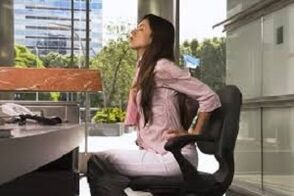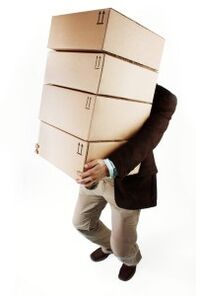Lumbar osteochondrosis is a common pathological disease of the spine. Cartilage tissue degenerates into bone, and intervertebral discs degenerate. The reduced size, ossified annulus fibrosus is unable to cope with the devaluing function of the vertebral body portion, putting pressure on the nerve endings in the spinal cord, which can lead to lower back pain.
Developmental stages of lumbar osteochondrosis
- The main sign of osteochondrosis development is discomfort in the lower back.
- The second stage is characterized by a herniated disc: destruction of the annulus fibrosus, narrowing of the intervertebral space, and pain when nerve endings are compressed.
- In the third stage, the spine is deformed, the annulus fibrosus is destroyed by the displacement of the intervertebral disc, and the contents ooze out. Intervertebral hernias form.
- The fourth stage is acute osteochondrosis of the lumbar spine. It is considered severe, and back pain interferes with movement.
symptoms of disease

The first sign of the development of osteochondrosis of the lumbar spine is the periodic disease, back pain. According to the slope of the infringement, the pain is shooting, pain, pain radiating to the legs, buttocks, thighs.
Characterized by disease after prolonged recumbency. A person cannot straighten for a period of time after sleep. In the lumbar region, pain of different nature occurs: dull, painful, insensitive soft tissue due to damage to nerve endings. Running with lumbar osteochondrosis brings pain and may drag your legs.
Usually, with the long-term squeezing of nerve roots, lumbosacral osteochondrosis develops, the work of internal organs is disrupted, reproductive organs are insensitive, and urogenital dysfunction occurs. Changes in the position of the discs cause partial damage to the blood vessels, resulting in vascular dystonia, in which blood does not flow to the lower body in sufficient quantities to circulate properly. Damage to internal organs, local numbness of the extremities, and convulsions were observed.
With sudden movements, coughing, back pain is observed - a sharp, rapidly disappearing pain, similar to an electric shock. With the development of lumbar disease, the lower extremity tendon reflex function is weakened.
If a disease is suspected and repeated pain occurs, it is recommended to consult a doctor for a diagnosis. Letting go is dangerous and the disease will continue to develop. Time wasted due to a negligent attitude towards health is not good for the patient.
cause of disease
Reliable causes of lumbar osteochondrosis are unknown. The disease is formed by a combination of adverse factors that affect changes in bone and cartilage tissue. Intrinsic factors affecting premature aging of bone tissue:
- endocrine system dysfunction;
- autoimmune disease;
- Improper metabolism;
- minimally invasive spine;
- hormone imbalance;
- body dehydration;
- hereditary.
External factors that affect the formation of the disease should be called the influence of environment, physical activity, and habits. factor:

- Periodic overstrain of the back muscles;
- weightlifting;
- muscle hypotension;
- Spinal cord overload;
- incorrect posture;
- malnutrition;
- bad habits;
- pressure.
Osteochondrosis of the lumbar spine usually occurs in people who do standing jobs: sellers, teachers, security guards.
At risk are occupations that involve electrical loads: athletes, builders, loaders. Common forms are sciatica, prolapse, disc displacement. The sedentary work of office workers, civil servants, programmers, drivers can cause back muscles to become weak. The work of maintaining an upright posture falls on the spine, the posture changes, nerve tissue, blood vessels are squeezed, and the limbs are numb.
Treatment of lumbar osteochondrosis
In the event of acute pain in the lower back, it is recommended to contact a medical institution for a comprehensive examination to determine the cause of the sensation. It could be appendix, biliary colic, another disease with main symptoms similar to lumbar osteochondrosis.
Depending on how advanced the disease is, the syndrome, a doctor will prescribe a treatment that includes medication, physical activity, health procedures, and diet. Surgical intervention is reasonable in the final stages of spinal modification. Medications include the use of ointments, injections, patches, and tablets. The dosage and course of treatment vary from person to person, depending on the condition.
- The first priority in the treatment of osteochondrosis is to relieve acute pain, tension, and muscle spasms. Application:
- NSAIDs in injectable, tablet form. After taking the pain subsides, tissue inflammation is reduced.
- Medications that relieve symptoms are pain relievers.
- Antispasmodics are short-lived and relax muscle fibers located around the focus of pain.
- Drugs that enhance microcirculation, increase blood flow to organs, and supply organs with oxygen and essential substances.
- Diuretics relieve swelling, pressure on the spinal area.
- To restore cartilage tissue, its nutrition uses two drugs:
- Chondroprotective agents - ointments, tablets, injections containing enzymes that promote cartilage tissue regeneration. Apply a long course of up to six months with a 2-3 month break.
- The vitamin complex accelerates the recovery of cartilage tissue, nourishes the intervertebral disc with essential substances.
- The main drug therapy is prescribed after the patient has undergone an MRI to determine the cause of the disease.
The appointments listed are short-term measures, they do not affect the course of the disease, they provide relief for the patient. To get rid of this disease, pain relievers and symptomatic drugs are essential. We need a smart, holistic approach.
For recovery, physiotherapy procedures that improve blood circulation and stimulate the muscles of the lower back are recommended. Effective methods are electrophoresis, magnetic field, ultrasound, and laser therapy.
In physiotherapy practice, yoga is in great demand for lumbar osteochondrosis. Simple poses that stretch and relax muscles and strengthen them. Without proper training for independent sports, trainer insurance can cause serious injury.
How to protect yourself from osteochondrosis?
Prevention of lumbar osteochondrosis involves regular back muscle training, an active lifestyle, and a proper balanced diet. The load on the waist must be even. Sleeping with a firm mattress can reduce the chance of getting sick. Regular annual visits to your doctor after age 40 will provide early diagnosis and reveal susceptibility.















































